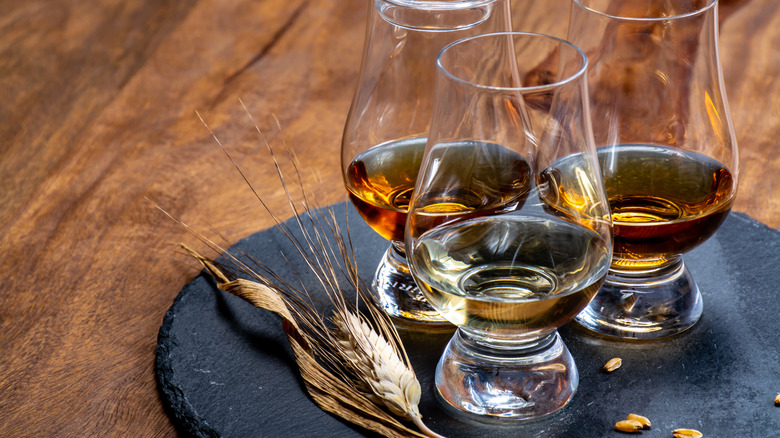Why You Should Always Use A Tulip-Shaped Glass To Drink Scotch
Single malt whisky is having a moment. It's jumped off the food and beverage magazine pages and onto market-watch business sections as the up-and-coming darling of the whisky world (via Forbes).
However, that still doesn't make it Scotch.
If the distilled spirits market is trying to master what Scotch has known how to deliver all along, it behooves us whisky lovers to come correct when savoring a true glass of Scotch. To do that, we need to be clear on what constitutes authentic Scotch in the first place and also be attuned to what vessel delivers the best Scotch experience. And if by vessel, you think "tumbler," think again.
Scotch heralds from, you guessed it, Scotland and Scotland alone. Much like a prosecco by any other name is still not champagne, Scotch has certain aging requirements (three years minimum), specific ingredient qualifiers (only barley, wheat, rye, or grain mixed with water and yeast, please), and all of this bottling and distilling must happen in one of the five Scotch Whisky regions of Scotland, says whisky collector and connoisseur Mark Littler.
Scotch got its start back in 1495 and, according to The Scotch Advocate, a drink of Scotch early on was called a dram. Today tasters know that when ordering a dram of Scotch, the glass that Scotch is delivered in makes a big difference.
What's the best way to drink Scotch?
If ever we neglect the fact that 80% of taste is first experienced by way of our sense of smell, the time to fix that is before your first sip of Scotch. To harness that Scotch aroma, it's imperative to use a bulbous-bottom glass. They range from fancy and award-winning, like The Glencairn Glass, to simple sets of tulip-shaped glasses. That big bottom gives you a great first view of any imperfections of your Scotch, but more importantly, it gives a wide space for all those aromas to collect.
The narrowing neck allows the taster some room for swirling their Scotch, a practice that releases the collective aromas intermittently, and allows them to sniff and sip without interrupting the integrity of the Scotch that's left in the glass.
And about that Scotch in the glass — do we water it? Add ice? Drink it neat? Chemically speaking, a splash of water suppresses the punch of "immature aromas," according to a study published in the Journal of the Science of Food and Agriculture. But in the end, ice, water, or neat is a personal preference. A little like the spelling of whisky, one might say, since spelling differs according to the preference of various parts of the world. Canada and Japan spell it "whisky," according to award-winning bottler Oak&Eden, while "whiskey," on the other hand, is distilled in America and Ireland.
For Scotch Whisky, the chosen spelling of distilleries in Scotland, drop the "e," grab a tulip-shaped glass and enjoy your Scotch, nose first.

